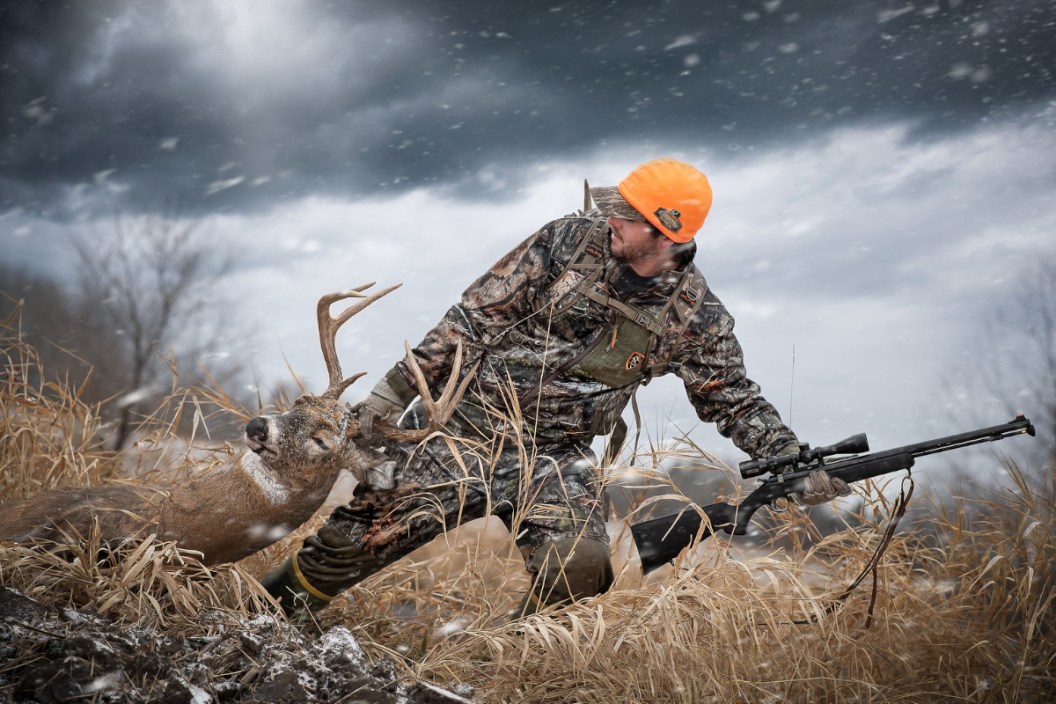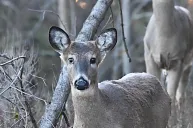Are antler point restrictions helping or hurting hunting?
As modern deer hunting continues to evolve in the 21st century, wildlife management officials are consistently looking at new ways of controlling and growing the deer herds in their states or provinces. There has been a monumental shift towards creating a better age structure in many areas that has led to new hunting regulations like antler point restrictions or "APRs" for short.
Hunters seem to either love or hate the concept of antler point restrictions. For the most part, they are being used for white-tailed deer management. The idea being that if you protect the young bucks, they will live to produce a bigger antler size and more balanced older age classes in the herd.
Depending on who you talk to, protecting yearling bucks with strict harvest criteria in place is either the best thing that has happened to their hunting area, or the worst. We will examine both sides of the issue to determine whether this idea is a good one for hunting or not.
What are antler point restrictions?
For those unfamiliar with the term, APRs protect smaller-antlered deer from harvest by putting heavy restrictions on the definitions of a legal antlered deer. Michigan, for example, has APRs in a select number of counties. Some counties mandate a buck has at least three points and others mandate four. And to make sure there is no confusion, the Michigan Department of Natural Resources defines a point on a deer's antler as being at least one inch in length from the tip to the nearest edge of the main beam.
Most states like Missouri and New York have wording that is similar in their hunting regulations. However, some states have taken a different approach to classifying a legal buck. Mississippi, for example, instead uses a minimum inside spread or main beam measurement for select deer management units.
Either way, by putting antler restrictions on what constitutes a legal big game animal, the hope is more antlered bucks survive to an older age, improving the hunting opportunity for a big buck for hunters who may not have gotten a chance previously. For the most part, these regulations are designed to protect year-old bucks, especially spikes and fork horns, who we can probably all agree, are some of the dumbest deer in the woods, and the most likely to get shot first because they are so naïve to the dangers of humans.
Do antler point restrictions work?
There are some conflicting scientific studies by biologists out there on the effectiveness of these restrictions on improving age class in deer populations. For the most part, you will find officials in states like Michigan and New York praising them. For example, in Michigan, studies of the counties that put restrictions in place have noted a buck harvest that has skewed towards older deer with bigger antlers. The New York Department of Environmental Conservation notes deer hunters harvested more bucks that were at least 2.5 years of age once APRs were put into effect. And as most hunters already know, bucks that make it to 2.5 or 3.5 years of age usually have much larger antler growth after being given time to mature.
It is worth noting that it is not always about antler size with state wildlife agencies either. In 2018, Michigan Out of Doors reported the counties with antler point restrictions saw a smaller dip in hunter participation than counties without them. Of course, there is something of a cultural shift towards an older deer harvest already happening, but the DNR has vested interest in doing anything they can to quell the number of hunters dropping out of the pastime forever. And while the Michigan DNR notes in that article, they cannot say with certainty APRs have improved the number of hunters participating, they also do not believe they have hurt growth either.
One of the more interesting studies we came across was from Mississippi State University's own study of antler point restrictions before and after restrictions on what defined a legal deer were put in place. After APRs were put in place, 2.5 and 3.5-year-old bucks started making up most the harvest. However, the study also notes a closer look at the stats reveals the overall success of hunters took a significant dip downward. And that seems to be common across the board. Putting in APRs greatly reduces the harvest of all bucks in general.
There is probably some merit to saying APRs are completely unneeded. Some sportsmen and women will also argue that many noted big buck states do not have any sort of antler restrictions in place. Big buck meccas like Kansas and Oklahoma are two prime examples. As is Wisconsin, which has a significant deer harvest every season. Yet they have produced more Boone & Crockett class bucks than any other state in the U.S. Another prime example is Ohio, which borders Michigan, yet no one talks about hunting in the Wolverine State with the same gusto they do about Ohio. Cue jokes about Wolverines vs Buckeyes here if you must.
Although we feel that with Ohio at least, one could argue their one buck a year rule does more to produce more mature bucks in the state than any restrictions on antlers could simply because it reduces the overall buck harvest every season without putting arbitrary restrictions on what one can and cannot shoot. Older bucks are a given when more of them start surviving every hunting season.
It is worth noting surveys of hunters in areas with APRs seem to indicate more hunters support them than hate them. In 2017, a survey of area hunters found a whopping 76% approved of them after they had been in place a few seasons. Make of that what you will.
Cons of antler point restrictions.
The science seems to indicate APRs essentially reduce the overall harvest. Especially in areas where the number of yearling bucks killed has dominated for years. That means a lot less meat in the freezer. One of the bigger complaints you will hear about APRs are from hunters who have no interest in the number of inches of antler on their buck. They just ant to feed their family. To be fair, we can see this side of the argument.
In a way, APRs could be considered hurtful to the image of hunters. There is already a growing wave of resentment towards "trophy hunting" out there. APRs arguably appeal more to the hunters looking for a trophy-size set of antlers than those who just want food. The little bit of growth we have seen in hunting the last few years seems to be people looking for organically sourced meals they harvest themselves than hunters looking for something for the wall. One can easily argue rules on what constitutes a legal animal could turn away these types of hunters. In a time when we need all the help we can get, alienating a new class of hunter seems like a bad idea.
Perhaps the biggest argument I have seen against APRs are considerations for youth hunters and we tend to agree. It really is not fair to ask younger hunters to conform to the same standards as the adults, especially when they do not have any deer of their own under their belt already. In fact, it could lead to some frustration with hunting if they go a whole season having to pass up everything that walks past because a legal animal never showed.
At the very least I am proud my home state of Michigan recognized this issue and made youth hunters under 16 totally exempt from following antler point restrictions regardless of where they hunt. If a hunter turns 17 during the season, they must follow APRs from then on. To me, this feels like a fair compromise of allowing younger hunters a solid chance at harvesting their first buck while also putting a fair amount of responsibility on young adults who probably already have a few years of hunting under their belt.
For what it is worth, the Quality Deer Management Association champions the use of APRs to protect younger bucks. However, they also state on their website they believe it should be voluntary rather than mandatory. That seems to be the sticking point with many people who are against them, when the APRs become a mandatory part of the regulations.
One last con is that there are sometimes bucks that are of an older age class that simply do not have four or more points on one side. It hurts to see a giant 4-point, or a monstrous 6-point that is an obviously older deer on the decline, and to not be able to harvest it even though it is the type of age class more wildlife agencies want hunters to take.
Pros of Antler Point Restrictions
The first and most obvious reason to like APRs is increased chances at a mature buck. Especially in areas with high hunting pressure where hunters do not often see deer that are three years of age or older. I live in southwest Michigan, and I have only seen and harvested two bucks that fit this description in 20 years of hunting. It can get a little frustrating to see nothing but smaller bucks every hunt. While not everyone may care, I have heard plenty of stories of hunters here in Michigan who have given up because they felt they would never shoot a larger buck. Which is just sad.
Another positive to APRs is they do seem to create a better balance of age classes in the deer herd. Antlered deer are almost always targeted before antlerless deer which seems to lead to a skewed sex ratio in many areas. In my part of Michigan, I'd estimate the buck to doe ratio is probably 20 to one at least. As a result, the deer here behave somewhat different than what I have observed in other states.
For one, the bucks are not nearly as aggressive in battling for mates because there are usually more than enough does to go around. In fact, I will argue for my part of Michigan, the firearms deer season does more to alter deer behavior than the rut does. The big bucks go nocturnal as soon as that season arrives which leads to tons of little guys getting killed first. Reducing the overall deer harvest through stricter APRs may lead to a little less pressure and more balanced buck to do ratios.
If we can get a more balanced herd, it may lead to more sightings of bigger deer. If you improve the quality of deer hunting in your area, you help hunter retention. More hunter retention means more dollars being pumped into licenses, and conservation as a result. More money for conservation is just good for the outdoors in general.
More states should at least study APRs.
If you are looking for my own opinion on this matter, I personally want to see APRs go statewide here in Michigan. I'm sick and tired of only seeing maybe one buck over 2.5 years of age every season. And that is if I'm lucky. I've spent a good deal of time in states like Wyoming during the rut, enough to know from the behavior of the whitetail and mule deer herds there that Michigan's herds are not balanced. Nor do they behave normally because of the ridiculous amount of hunting pressure placed upon them every season. It's a blood bath out there in mid-November and the deer act accordingly to the slaughter. I just want to see some of the normal deer activity you see and read about on the Internet in other states.
I do worry about public perception with APRs since they are associated so much with trophy hunting. However, at this point I feel like hunters have more to lose than gain by not trying them. I would even be fine with the DNR just trying them temporarily statewide to see if they have a positive effect upon the herd and hunting. Because Michigan is one of those states that is losing hunters like a bucket with holes drilled in it. We must do something to stop all those leaks. Or at the very least we should try something new. Even if it may seem a little extreme and unpopular to some. Because if there is one thing I have learned from living in Michigan my whole life, and hunting here the last 22 years, it's that the state's current ways of deer management aren't working.
At the very least, wildlife management agencies should at least study them as a facet of wildlife management. Because we need all the tools we can get right now for hunter retention and preservation of the wild spaces we all know and love.
For more outdoor content from Travis Smola, be sure to follow him on Twitter and check out his Geocaching and Outdoors with Travis YouTube channels.
NEXT: THE AXIS DEER AND HOW THEY'RE IMPACTING PARTS OF THE UNITED STATES
WATCH





